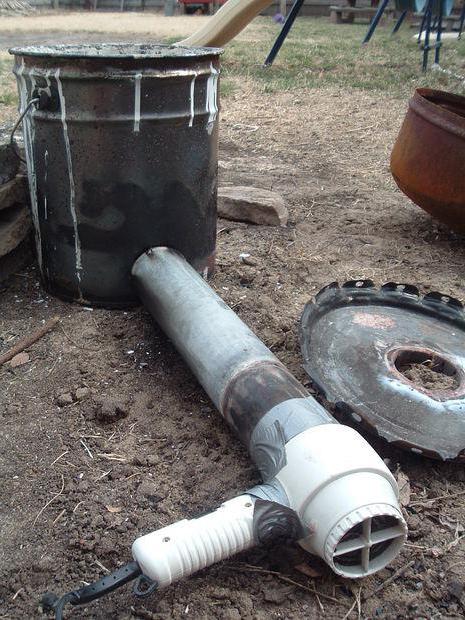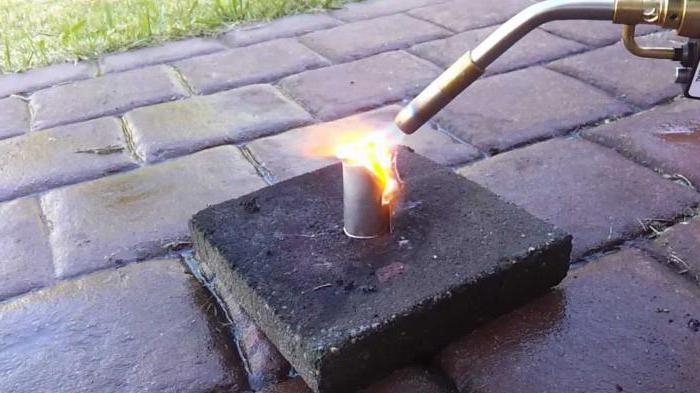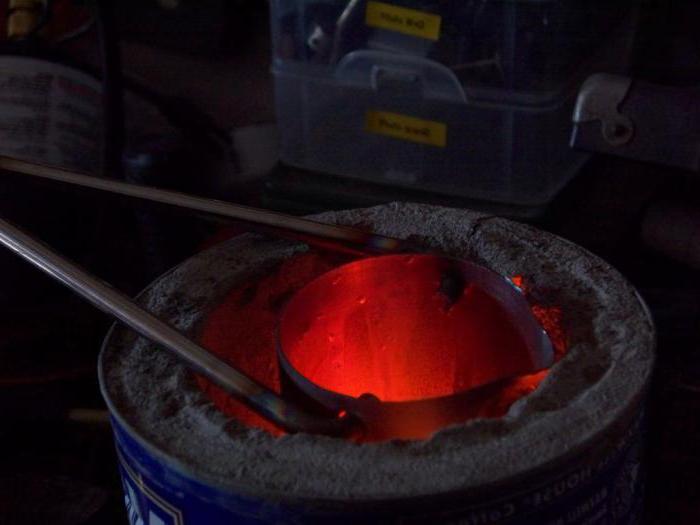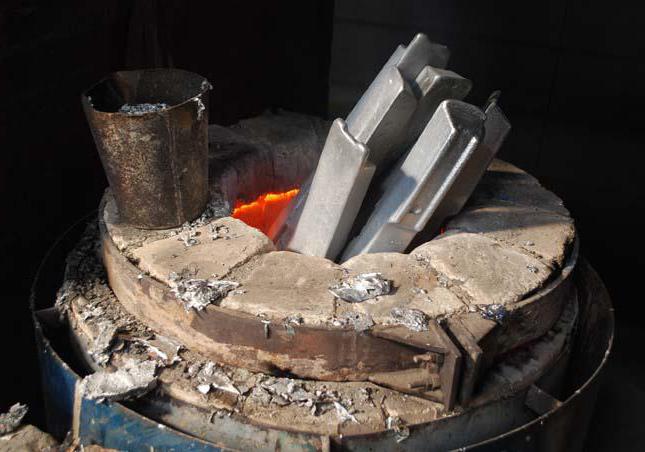Aluminum is one of the most common metals on earth. It is present even in the human body, so to speak about the surrounding reality. Each house or personal car has aluminum functional elements, parts or assemblies, which, alas, often break down. These are furniture and window fittings, guides for doors and shutters, latches of locks and other necessary trifles.
They can be replaced with purchased new products, repaired or made independently. In the last two cases, it may be necessary to melt aluminum at home.
Characteristics of aluminum
It is not necessary to know all the characteristics of metal for homemade products. But there are a few points that can become significant or even dangerous at work.
Aluminum is good for casting, it melts at a relatively low temperature of 660 ° C. For reference: cast iron begins to melt at a temperature of 1100 ° C, and steel - 1300 ° C.
Therefore, the melting of aluminum at home on a gas stove is difficult, since home gas appliances cannot provide such a temperature. True, domestic "kulibins" can do everything, but more on that later.
It is possible to reduce the melting temperature of aluminum by grinding it into powder or using a finished powder product as a raw material. But here is another important property of aluminum. It is a fairly active metal, which, when combined with oxygen in the air, can ignite or simply oxidize. And the melting point of aluminum oxide is more than 2000 ° C. During melting, the oxide is still formed, but in small quantities, it forms the scale.
The same activity can play a bad joke if water gets into the molten metal. In this case, an explosion occurs. Therefore, if you need to add raw materials during the smelting process, you need to ensure that it is dry.
Raw materials for smelting
If you have to smelting aluminum at home, because of the complexity of working with powder metal, it is not used as a raw material.
You can purchase aluminum ingot or use ordinary aluminum wire, which you can cut into small pieces with scissors and tightly compress with pliers to reduce the area of contact with air.
If it is not expected that the product is of a particularly high quality, then any household items, cans without a lower seam or trimming profile can be used as raw materials.
Recycled materials can be stained or stained, it is not scary, the excess components will go to slag. Just remember that inhaling fumes of burnt paint is not allowed.
In order to make high-quality aluminum smelting at home from secondary materials, fluxes, the task of which is to bind and remove all impurities and impurities to the surface of the molten metal, it is better to purchase ready-made ones. But you can do it yourself from technical salts.
The coating flux is prepared from 10% cryolite and 45% sodium chloride and potassium chloride each.
An additional 25% of the total mass of sodium fluoride is added to the refining flux to obtain aluminum without porosity.
Personal protective equipment for melting
Smelting aluminum at home is an unsafe process. Therefore, you need to use personal protective equipment (PPE).Even if such smelting is needed once with minimal equipment, at least you need to protect your hands, for example with special gloves of the welder, which perfectly protect against burns, because the temperature of liquid aluminum is more than 600 ° C.
It is also advisable to protect the eyes, especially if melting occurs often enough, with glasses or a mask. And quite ideally, you need to work in a special suit of a metallurgist with increased resistance to fire and high temperatures.
If you need very pure aluminum using refining flux, you should work in a chemical respirator.
Casting shape
If you only need to cast pure aluminum for solder, then a mold is not needed. It is enough to use a steel sheet on which the molten metal cools down. But if you need to cast at least a simple piece, you will need a mold.

The mold can be made of sculptural gypsum, namely gypsum, and not alabaster. Liquid gypsum is poured into a greased form, it is allowed to solidify a little, periodically shaking so that air bubbles come out, insert the model into it and cover it with a second container with gypsum. In a convenient place you need to insert a cylindrical object into the gypsum, so that a hole appears in the form, the so-called channel, into which molten aluminum will be poured. When the gypsum finally hardens, the two parts of the mold are disconnected, the model is taken out, and the mold with the finished cast is connected again.
A mold can also be made from a mixture of 75% foundry sand, 20% clay and 5% coal sand, which is poured into a special box from boards and rammed. A model is squeezed into the compacted earth, the resulting print is sprinkled with talc and graphite (coal dust) so that the cooled aluminum part can be easily separated from the mold.
Crucible for melting
Smelting aluminum at home requires a special container with a spout made of refractory material. This is the so-called crucible. Crucibles can be porcelain, quartz, steel, cast iron, made of corundum or graphite. At home, you can use a purchased crucible or make it, for example, from a piece of steel pipe of a sufficiently large diameter. True, for this you need a grinder, a welding machine and skills in using these tools.
The dimensions of the crucible depend on the required amount of aluminum to be melted. This bucket should be heated evenly, and its heat should be transferred to the raw materials.
Smelting furnaces
The technology of smelting aluminum at home is quite simple. In a special ladle, aluminum scrap is heated to a temperature exceeding the melting temperature of this metal, the melt is kept in a heated state for some time, slag is removed from its surface, then the pure metal is poured into a cooling mold. Melting time depends on the design of the furnace, that is, the temperature that it can provide.
If a blowtorch or gas burner is used, they heat the aluminum from above. True, the furnace at the same time still consists of bricks with a well without a binder solution, inside which coals will be burned to heat the tank from below and maintain it in a heated state.
The design of the furnace looks approximately the same if the crucible is heated from below using ordinary firewood and a hair dryer. Only in this case, the wood is not laid in the brick well not on the bottom, but on the grate located on the first row of bricks, and in this row there is an opening for a metal pipe, put on the neck of the hair dryer and secured with electrical tape. The crucible in this case is a can, naturally, not aluminum, in which diametrically opposite through holes are made at a small distance from the top. A steel bar is threaded through these holes, for which the can should be suspended in the furnace. A hairdryer is needed to pump hot air into the space between the bricks and the crucible.Sometimes a metal barrel is used instead of bricks.
If melting should occur often enough, then you can make a muffle furnace with a vertical crucible loading yourself or buy a finished one yourself.
Blowtorch melting
Melting of aluminum at home with a blowtorch should not take place indoors. In addition to raw materials, blowtorch, crucibles and bricks, you need to prepare firewood, pliers and a steel bar.
So, a small well is made of bricks so that a ladle with aluminum and a small steel sheet can be installed on top. A bonfire is being kindled in the well, which should burn a little to form coals.  Further, the actual melting of aluminum occurs at home. Step-by-step process instruction:
Further, the actual melting of aluminum occurs at home. Step-by-step process instruction:
- A container with raw materials is installed on the bricks. It needs to be heated for about 15 minutes.
- After that, the blowtorch burner turns on at full power and the aluminum warms up from above.
- Within a few seconds, the process begins, but in order for the heating to be uniform, the metal in the container must be gently mixed with a steel bar, holding it with pliers (without forgetting to wear gloves). You can do without a rod, periodically shaking the bucket with the same pliers, but very carefully.
- When the liquid becomes homogeneous, you need to use a pair of pliers to take the container and pour the contents onto the calcined steel sheet so that all the formed scale remains in the bucket, and only pure metal gets onto the set sheet.
So usually pure aluminum is obtained from recycled materials if aluminum parts need to be soldered with it.
Wood or gas melting
Melting of aluminum at home on wood occurs in lightweight collapsible furnaces. The disadvantage of this method is the uncontrolled process. It is not possible to increase or decrease the heating temperature. It is possible to intervene in the process only by removing the aluminum container from the fire.
Smelting aluminum at home on gas is the only option for an apartment. It is necessary to warm the tank for a long time, periodically draining the molten metal. In this case, the casting is performed in layers. For work, you will need two metal containers of such diameters so that one is worn on the other. The smaller one serves as a crucible. She with a crowbar, such as chopped aluminum wire, is placed on the burner, from which it is necessary to remove the flame divider, household gas stove. You will have to work on a larger capacity. About a dozen small holes are made in its bottom. Bolts are screwed into two or three of them, which play the role of handles, for which a hot container can be lifted with pliers.
This container is put upside down on the crucible. This design allows you to warm the aluminum. Periodically, the upper container must be removed and a scrap with a metal rod or knife. Before merging molten metal, slag must be removed from its surface.
Smelting aluminum in a muffle furnace
A muffle furnace is already serious enough equipment to produce high-quality molten metal. Therefore, when melting, flux is used to clean aluminum from impurities. And this is almost an industrial process, and not aluminum smelting at home.  Step-by-step instructions also include several points for the preparation of raw materials:
Step-by-step instructions also include several points for the preparation of raw materials:
- First, the flux melts in the crucible, which must be taken in an amount from 2 to 5% by weight of aluminum, and then scrap is added to it.
- How active the flux can be determined by the surface of the melt - it should be mirrored. If this is not the case, a little more flux is added to the melt, then it will be necessary to add it before the end of melting, so that the slag can be more easily removed from the metal surface with a steel spoon.
- Melting should be carried out at approximately 700-750 ° C. This is the temperature of the red glow.
- During the melting process, it may be necessary to add raw materials to the crucible, since the molten metal is greatly reduced in volume.
- Refining flux is added, if necessary, at the end of the heat in the amount of 0.25% by weight of the molten metal. Maintaining such a proportion at home is not an easy task. After adding the flux, the melt must be mixed with a spoon, allowed to stand for about 5 minutes, then remove the slag.
- When, as a result of heating, aluminum has turned into a uniform shiny drop, the crucible needs to be kept in the furnace for some time to make the metal more fluid.
- Then the aluminum from the crucible through the nose (at this moment it becomes clear why such a ladle is needed) is poured into a mold by a continuous thin stream.
- After complete cooling, the form is neatly divided into halves, a finished part is removed from it, which still needs to be finished: drill holes, if necessary, clean and sand the surface with sandpaper. That's all. The process is completed.
So do not be scared in advance if you have to melt aluminum scrap at home in order to get pure metal or make a part instead of a broken one. Serious professional skills for organizing such a foundry are not needed at all. The desire and skillful hands of an ordinary amateur master can work wonders.






